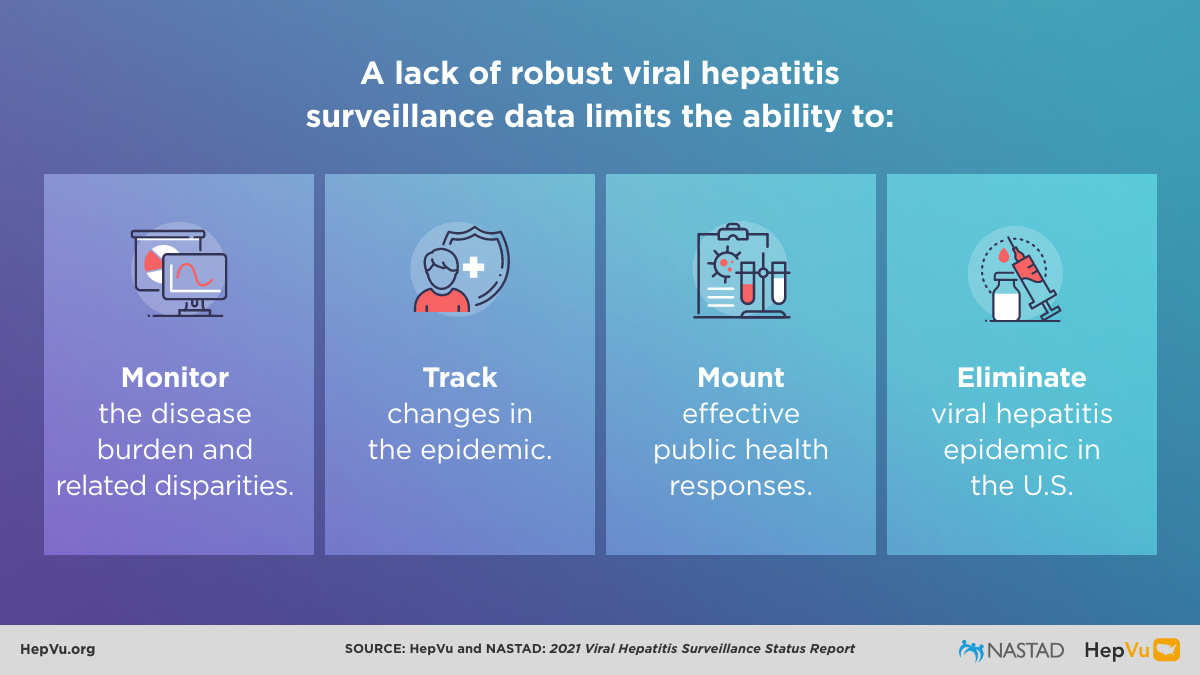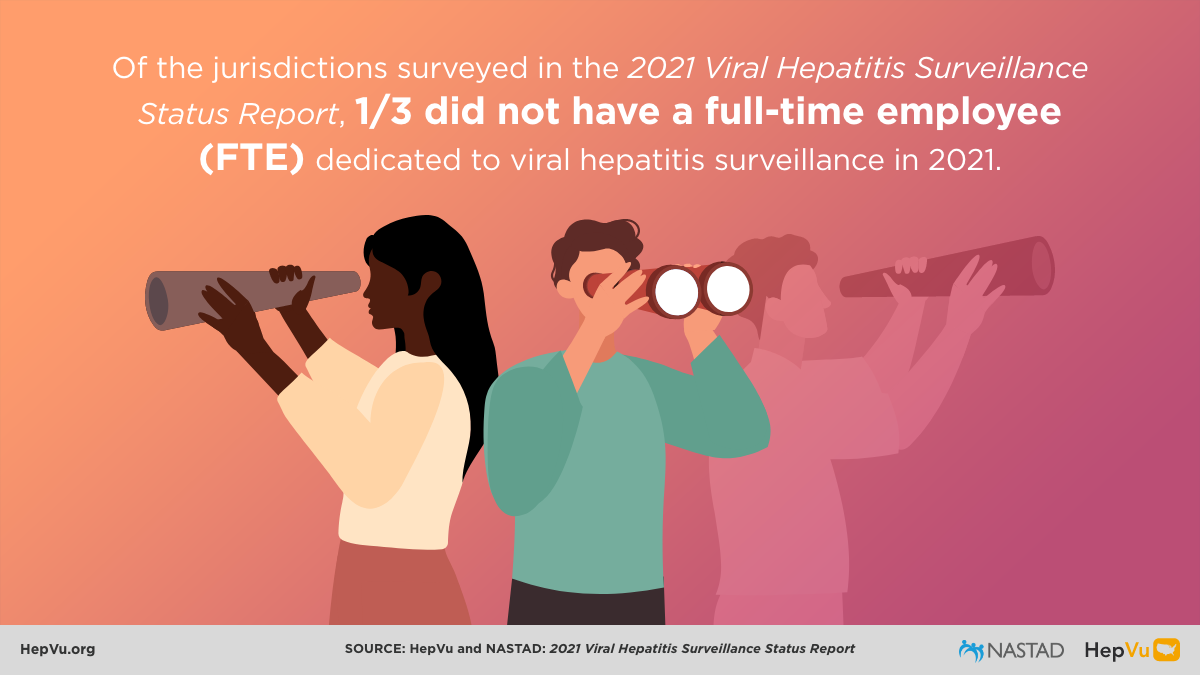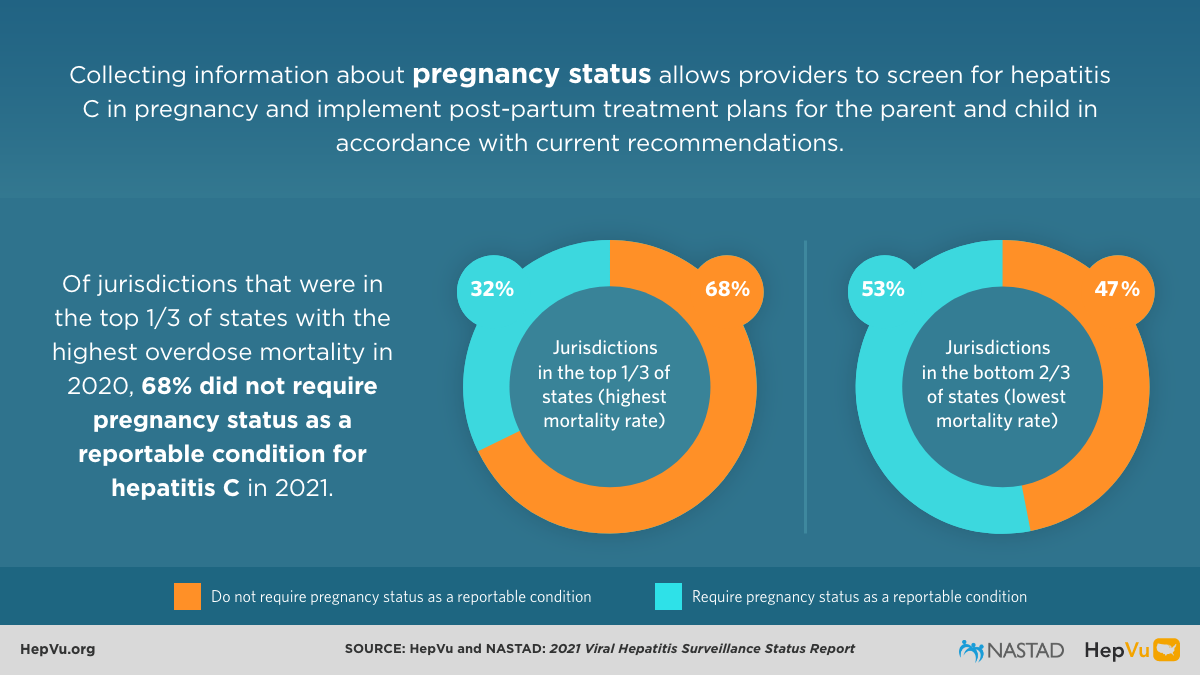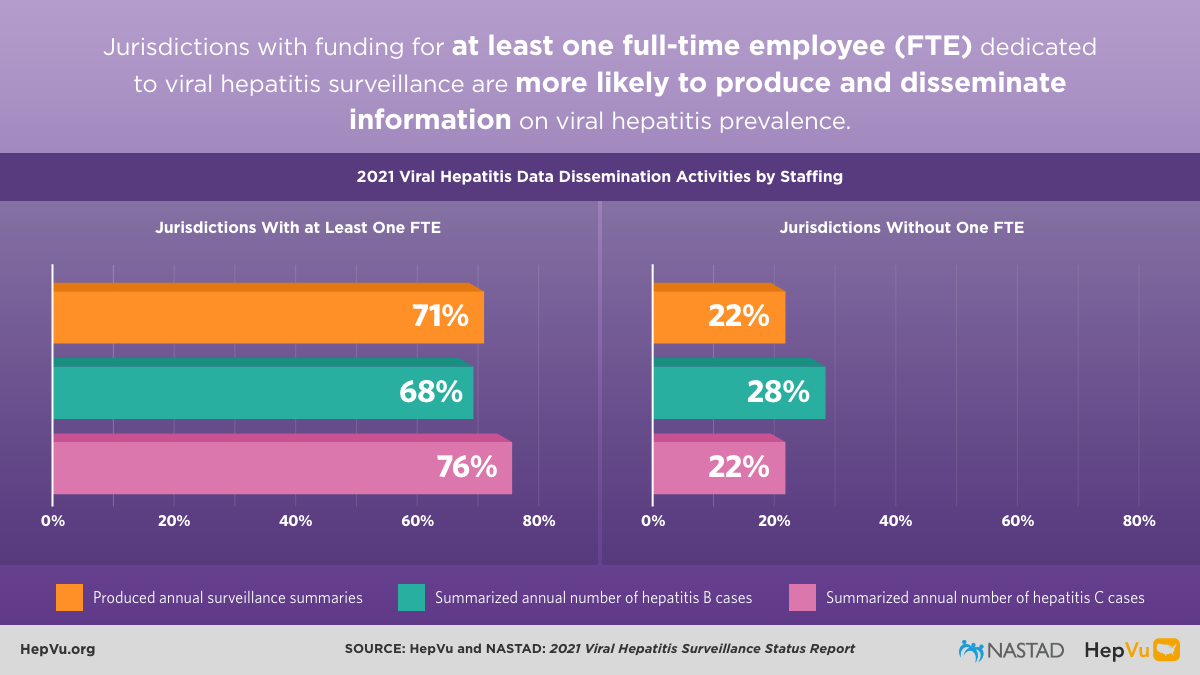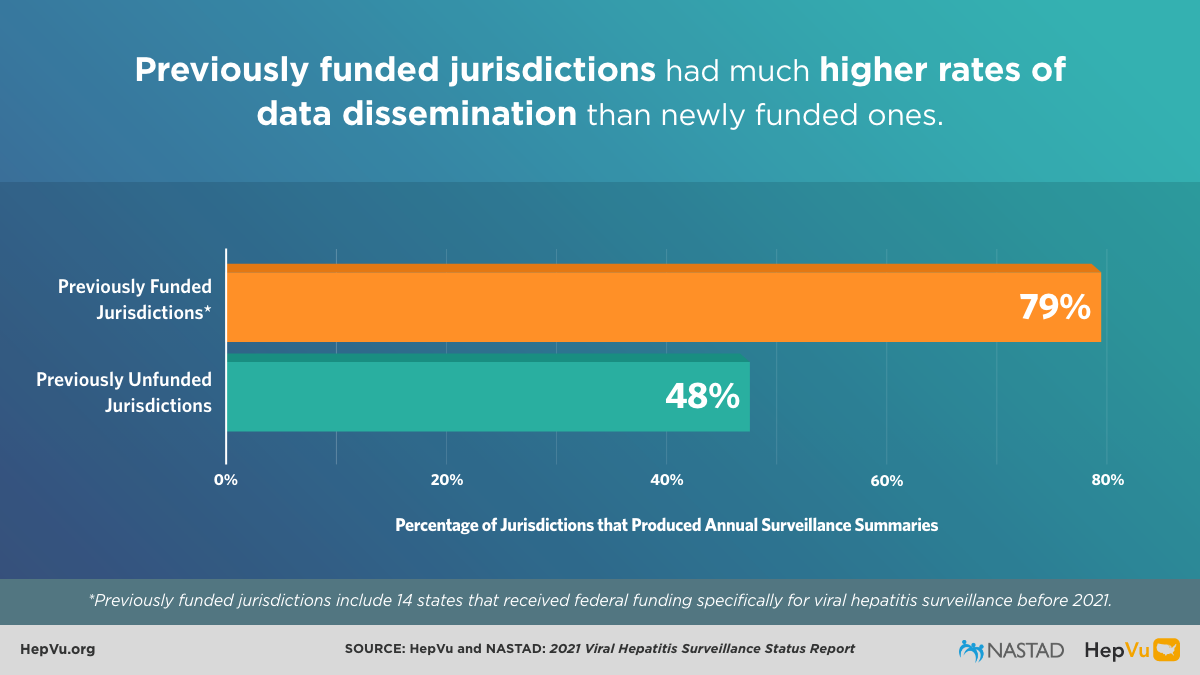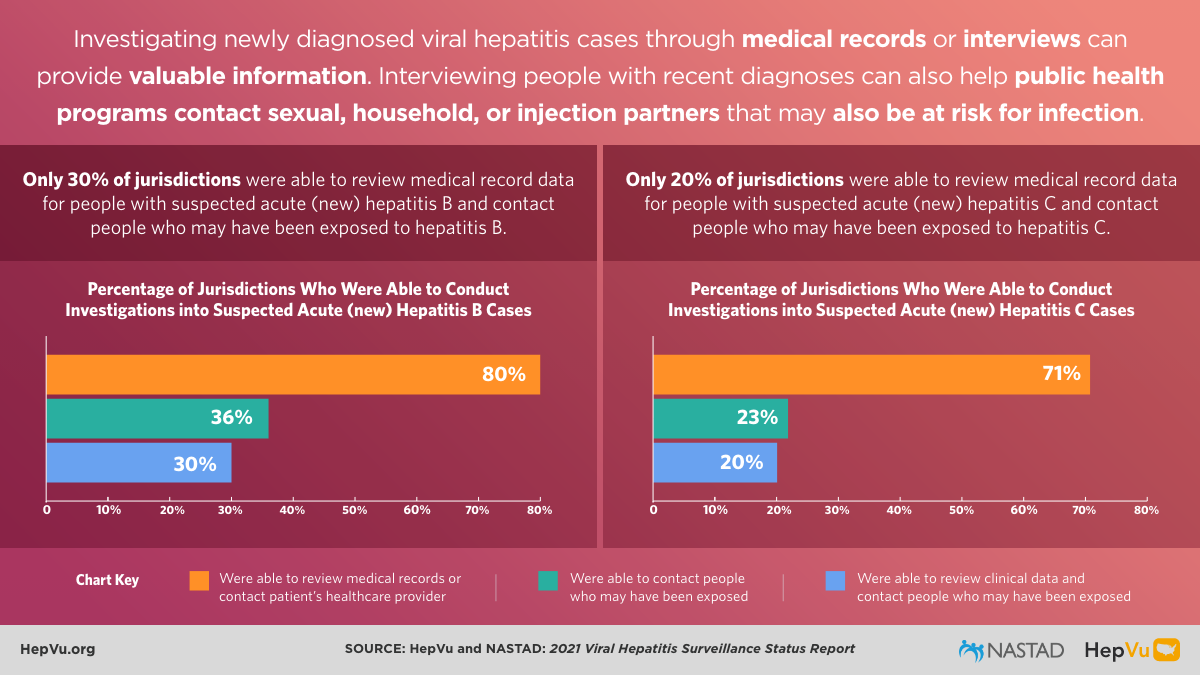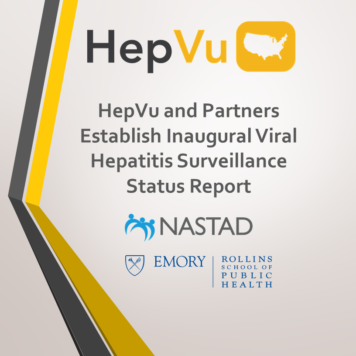Today, HepVu and NASTAD released the first-ever assessment of viral hepatitis surveillance practices across U.S. jurisdictions, showing that while public health professionals are doing commendable surveillance work with currently available resources, there is a need for additional funding and resources. In 2021, one-third of U.S. jurisdictions did not have a full-time employee dedicated to viral hepatitis surveillance, even though staff and dedicated time are needed to perform basic surveillance activities. Meanwhile, only half (55%) of jurisdictions were able to produce annual surveillance summaries in 2021, which are important for informing programmatic planning and resource allocation.
An estimated 2.4 million people in the U.S. are living with hepatitis C infection, while up to 1.59 million people could be living with hepatitis B in the U.S. Viral hepatitis surveillance programs need to be expanded to help ensure effective prevention, testing, and treatment of hepatitis infections. Collecting information through surveillance can help us to answer important questions and understand viral hepatitis burden, which groups of people have increased chances of getting viral hepatitis, how many people need care, testing, and treatment, and where there are inequities.
In 2021, the Centers for Disease Control and Prevention (CDC) released funding for hepatitis C surveillance across 59 jurisdictions. Prior to 2021, only 14 states received federal funding specifically for viral hepatitis surveillance. This inaugural viral hepatitis surveillance status report benchmarks the state of viral hepatitis surveillance in the U.S. prior to funding dissemination and establishes a baseline to monitor changes over time as additional resources are allocated. The primary intent of the report is to assess how jurisdictions across the U.S. are measuring the impact of viral hepatitis on their communities and to highlight areas in need of additional resources.
“Viral hepatitis prevention and treatment programs should be guided by data – data that are gathered and disseminated through robust surveillance systems. This first look at viral hepatitis surveillance practices across U.S. jurisdictions clearly shows there is a need for additional funding and resources if we are going to truly understand the burden of viral hepatitis. Understanding burden of disease is the first step toward reaching national and local hepatitis elimination goals,” said Heather Bradley, PhD, Associate Professor of Epidemiology at Emory University’s Rollins School of Public Health, and Project Director for HepVu.
“I applaud jurisdictions for all they have accomplished thus far with the resources available to them, as well as CDC, for recognizing this vital need and taking steps to provide jurisdictions with additional funding and resources. It will be important to continue monitoring changes in surveillance practices over time as federal resources are allocated, so that resources can be adjusted as needed.”
The need for expanded, standardized, and reliable viral hepatitis surveillance continues to impact public health efforts, resources, and response across the U.S. to this epidemic. A lack of robust surveillance data limits the ability to:
- Monitor the disease burden and related disparities
- Track changes in the epidemic
- Mount effective public health responses
- Eliminate the hepatitis C epidemic in the U.S.
“Reliable and standardized surveillance is necessary to impact public health efforts, resources, and response across the U.S. to the viral hepatitis epidemic,” said Boatemaa Ntiri-Reid, J.D., M.P.H, Senior Director of Syndemic Approaches at NASTAD. “I’m thrilled this report is now available to health departments, researchers, advocates, and other viral hepatitis community members to use as they talk to local leaders, departmental decision makers, and policymakers about why we need more attention on and resources for viral hepatitis surveillance – to ultimately impact our efforts in eliminating viral hepatitis in the U.S.”
For the full report and additional insights, download the report here and share our infographics or read an expert Q&A about viral hepatitis surveillance.
How to Use the Viral Hepatitis Surveillance Status Report
This inaugural viral hepatitis surveillance status report benchmarks the state of viral hepatitis surveillance in the U.S. prior to funding dissemination, establishes a baseline to monitor changes over time as federal resources are allocated, assesses how jurisdictions across the U.S. are measuring the impact of viral hepatitis on their communities, and highlights areas in need of additional resources.
The report, and future report updates, can be used to:
- Monitor progress and trends in viral hepatitis surveillance practices nationally and by jurisdiction;
- Inform advocacy efforts to increase viral hepatitis surveillance funding and resources;
- Inform public health planning.
About the Survey
HepVu and NASTAD collaborated to create this first-ever viral hepatitis surveillance status report. HepVu is an interactive online mapping tool that visualizes the impact of the viral hepatitis epidemics on communities across the United States to promote data-driven public health decision-making. NASTAD is a leading non-partisan non-profit association that represents public health officials who administer HIV and viral hepatitis programs in the U.S. to end HIV/AIDS, viral hepatitis, and intersecting epidemics. We worked with a steering committee comprised of state and local health department representatives, national policy/advocacy organizations, and researchers to develop a set of indicators for survey measurement, determine process, develop a survey, and disseminate results.
In March 2022, a survey requesting information on hepatitis B and C surveillance practices in 2021 (January-June) was sent to 59 state, local, and territorial jurisdictions across the U.S., and 95% of jurisdictions responded. Data were processed by Emory University and compared to additional indicators like prior viral hepatitis funding, overdose mortality, and other factors. Moving forward, HepVu and NASTAD will collect data from jurisdictions on these indicators each year, analyze the results, and prepare a status report describing findings.
About HepVu
HepVu.org is presented by Emory University’s Rollins School of Public Health in partnership with Gilead Sciences, Inc. and the Center for AIDS Research at Emory University (CFAR). HepVu’s mission is to make data widely available, easily accessible, and locally relevant to inform public health decision-making and action. The platform visualizes data, presents insights, and catalyzes research on the viral hepatitis epidemic in the U.S. Each year, HepVu strives to increase the granularity of its publicly available data and continues its commitment to provide public health officials, policymakers, healthcare professionals, researchers, and community leaders with a more comprehensive view of the viral hepatitis epidemic at the local, state, and national levels.

